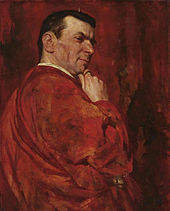Ludwig Keller (painter)
Ludwig Paul Wilhelm Keller (born June 20, 1865 in Duisburg , † December 28, 1925 in Düsseldorf ) was a German history , landscape , marine , genre and portrait painter from the Düsseldorf School . From 1902 to 1925 he was a professor at the Düsseldorf Art Academy .
Life

Keller, descendant of Duisburg mayor Hendrik Keller (1622–1690), studied at the Düsseldorf Art Academy from 1883 to 1894/1895, interrupted by military service in 1889. His teachers at the academy were Heinrich Lauenstein , Hugo Crola , Adolf Schill , and Wilhelm Sohn and above all Peter Janssen the Elder , in whose classes he took part from 1885 to 1894/1895. Together with Otto Modersohn and Peter Philippi , Keller founded the Tartarus student artist association in 1885 .
Between 1890 and 1905 he made several trips to the Netherlands . In 1902 he stayed in Volendam . In the same year he received a professorship at the Düsseldorf Academy. Emil Arends , Wilhelm Brandenberg , Max Burchartz and Ulrich Leman were among his students . Around 1921, Keller took over from Ludwig Heupel-Siegen as head of the women's art school at the Düsseldorf State Art Academy.
Keller stood out in particular through portraits of men, which are characterized by strong, luminous coloring. One of these portraits is a portrait of his teacher Janssen. He also tried his hand at plastic. In 1900 he created the mural Welcome to Prince Blücher and the Quadriga from the Brandenburg Gate in Duisburg 1814 for the auditorium of the Realgymnasium in Duisburg on behalf of the Art Association for the Rhineland and Westphalia . Between 1894 and 1913, he primarily sent the Munich Glass Palace and the great Berlin art exhibitions .
On the occasion of the centenary celebrations for the founding of the Krupp cast steel factory in Essen , Keller wrote an allegorical knight's play entitled Hie Barbara! Here St. George! , for whose monumental performance in 1912 around four hundred amateur actors were planned. In addition, Keller was a member of the Malkasten artists' association . In the park of the Malkasten-Haus he performed the festival play The young Goethe at Jacobi's in Pempelfort .
His son Gerhard Keller (1905–1984) was also a painter.
literature
- Friedrich Schaarschmidt : On the history of Düsseldorf art, especially in the XIX. Century . Art Association for the Rhineland and Westphalia, Düsseldorf 1902, pp. 354 , 366–368 .
- Keller, Ludwig . In: Hans Vollmer (Hrsg.): General lexicon of fine artists from antiquity to the present . Founded by Ulrich Thieme and Felix Becker . tape 20 : Kaufmann – Knilling . EA Seemann, Leipzig 1927, p. 113 .
Web links
- Ludwig Keller , data sheet in the portal rkd.nl ( Rijksbureau voor Kunsthistorische Documentatie )
Individual evidence
- ^ Duisburg research , Mercator-Verlag, Duisburg 2002, p. 82.
- ↑ finding aid 212.01.04 student lists the Dusseldorf Art Academy , the portal website archive.nrw.de ( State Archive of North Rhine-Westphalia ).
- ↑ Roland Demme: From the rectory to anti-Semitic politics. Agitation by Friedrich Bindewald and his role model Dr. Otto Böckel against the Jewish population in the Wilhelminian era and its effects until today . Kassel 2015, ISBN 978-3-86219-932-7 , p. 56 ( Google Books ).
- ↑ 3. Art Institutes, Staatl. Art academy. Women's art school: Prof. L. Keller. , in address book for the city of Düsseldorf 1922, p. 43
- ^ Peter Friedemann: Structural change and cultural life. Political culture in Bochum 1860–1990 . Klartext Verlag, Essen 1992, ISBN 978-3-88474-009-5 , p. 154.
- ↑ Carl Murdfield : From the chronicle of the "Malkasten" . In: Velhagen & Klasings Monatshefte , 42, 1927/28, Volume 1, pp. 617–632 ( PDF ).
- ↑ Ruth Keller: Pictures have their story. On the life and work of Gerhard Keller. Wachtberg 1995, ISBN 3-00-000356-8 .
| personal data | |
|---|---|
| SURNAME | Keller, Ludwig |
| ALTERNATIVE NAMES | Keller, Ludwig Paul Wilhelm (full name) |
| BRIEF DESCRIPTION | German history, landscape, marine, genre and portrait painter from the Düsseldorf School |
| DATE OF BIRTH | June 20, 1865 |
| PLACE OF BIRTH | Duisburg |
| DATE OF DEATH | December 28, 1925 |
| Place of death | Dusseldorf |